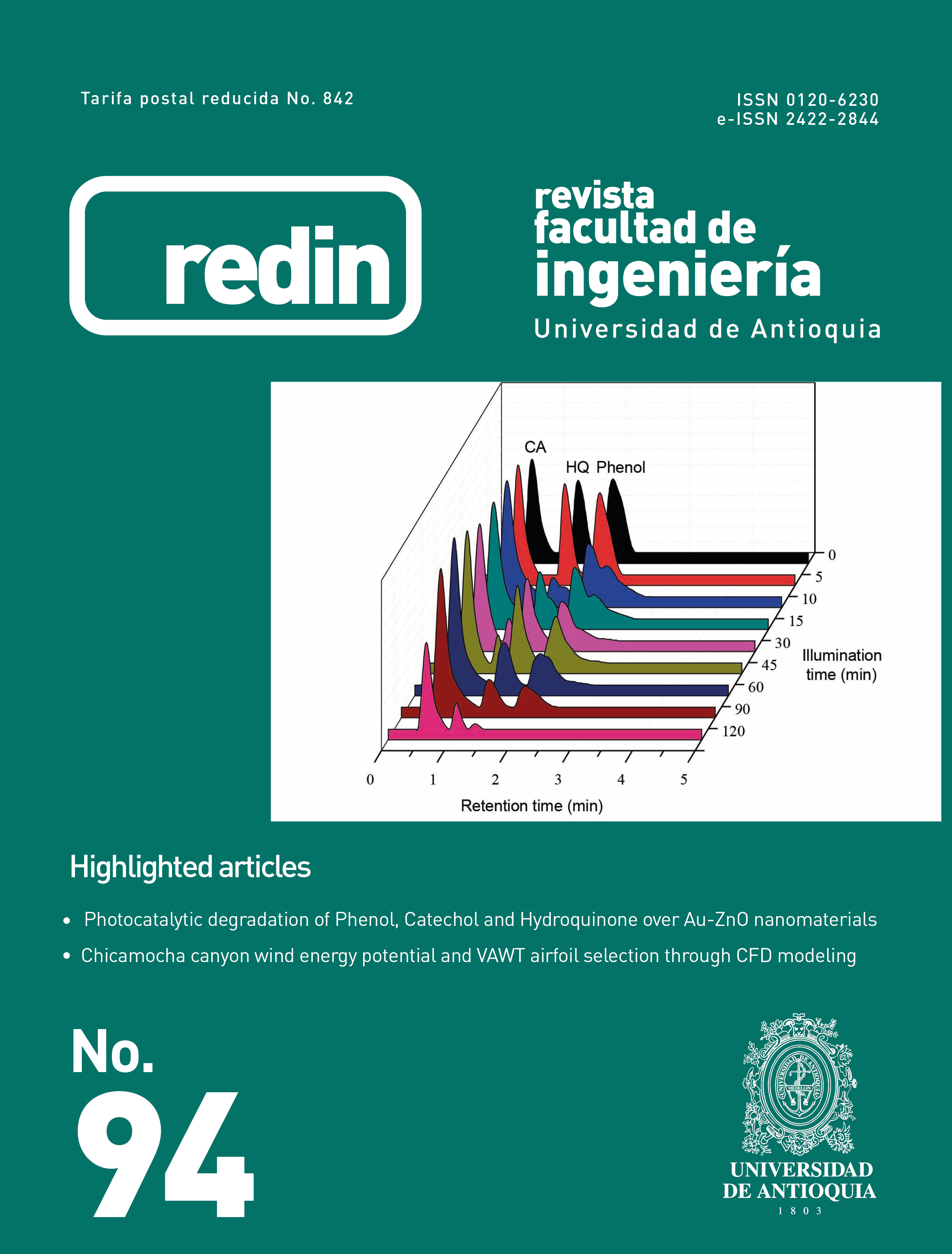Evaluación de un panel de acondicionamiento acústico elaborado de fibras típicas colombianas
DOI:
https://doi.org/10.17533/udea.redin.20191032Palabras clave:
guadua angustifolia, fibras naturales, acondicionamiento acústico, paneles perforados, desarrollo sostenibleResumen
La implementación de un panel perforado hecho con fibras de guadua, después de su caracterización acústica ha sido realizada. Las características acústicas de la fibra son identificadas y posteriormente, el comportamiento acústico del sistema de absorción es analizado. Con esto, se verifica la posibilidad del uso de fibras naturales y bioresiduos para sistemas cuya finalidad es traer bienestar acústico a la sociedad. En este sentido, la presente investigación está alineada con los principios de Desarrollo Sostenible acordados en Río de Janeiro, en 1992.
Descargas
Citas
UNESCO, “The rio declaration on environment and development,” in The United Nations Conference on Environment and Development, Rio de Janeiro, BR, 1992.
D. Páez, M. Herrera, and L. Calderón, “Possibilities for the develop-ment of acoustic-mechanical ystems based on Colombian typical fibres,” in 23rd International Congress on Sound and Vibration 2016(ICSV 23), Athens, Greece, 2016, pp. 4030–4037.
D. Páez, L. Herrera, O. Acosta, S. García, and M. Herrera, “Develop-ment of a perforated panel for acoustic conditioning based on Colombian guadua fiber (Guadua Angustifolia Kunth),” Tecciencia, vol. 13, no. 25, June 20 2019. [Online]. Available: http://dx.doi.org/10.18180/tecciencia.2018.25.2
H. Mamtaz, M. Foulad, M. Al-Atabi, and S. Namasivayam, “Acoustic absorption of natural fibers,” Journal of Engineering, vol. 2016, no. 7, January 2016. [Online]. Available: http://dx.doi.org/10.1155/2016/5836107
J. Arenas and M. Crocker, “Recent trends in porous sound-absorbing materials,” Sound & vibration, vol. 44, no. 7, pp. 12–17, Jul. 2010.
A. Salas and M. Barbero, “Implementación de tecnologías constructi-vas con fibras vegetales que sean sostenibles en contextos de precarie-dad,” in IV Congreso Internacional de Estudios del Desarrollo REEDES, Córdoba, Esp., 2018.
C. Burattia, E. Belloni, E. Lascaro, G. López, and P. Ricciardi, “Sustai-nable panels with recycled materials for building applications: Environ-mental and acoustic characterization,” Energy Procedia, vol. 101, Novem-ber 2016. [Online]. Available: https://doi.org/10.1016/j.egypro.2016.11.123
ISO 10534-2:1998 Acoustics — Determination of sound absorption coe-fficient and impedance in impedance tubes — Part 2: Transfer-function method, ISO, 1998.
ISO 3382-2:2008 Acoustics — Measurement of room acoustic parame-ters — Part 2: Reverberation time in ordinary rooms, ISO, 2008.
K. Jambrosic, M. Horvat, and H. Domitrovic, “Reverberation time mea-suring methods,” J. Acoust. Soc. Am., vol. 123, no. 5, June 2008. [Online]. Available: https://doi.org/10.1121/1.2934829
M. Garai, “On the single number rating of sound absorption,” Building Acoustics, vol. 1, no. 3, September 1 1994. [Online]. Available: https://doi.org/10.1177/1351010X9400100304
E. Mommertz, “Angle-dependent in-situ measurements of reflection coefficients using a subtraction technique,” Applied Acoustics, vol. 46, no. 3, 1995. [Online]. Available: https://doi.org/10.1016/0003-682X(95)00027-7
M. Estrada, D. Linero, and F. Ramírez, “Constitutive relationship of the fiber cluster of bamboo Guadua angustifolia, determined by means of a weibull probability function and a model of progressive failure,” Mecha-nics of Materials, vol. 63, August 15 2013. [Online]. Available: https://doi.org/10.1016/j.mechmat.2013.04.007
H. C. Birnboim and J. Doly, “A rapid alkaline extraction procedure for screening recombinant plasmid DNA,” Nucleic Acids Res., vol. 7, no. 6, November 24 1979. [Online]. Available: https://doi.org/10.1093/nar/7.6.1513
M. Karjalainen, P. Antsalo, A. Mäkivirta, T. Peltonen, and V. Välimäki, “Estimation of modal decay parameters from noisy response measure-ments,” J. Audio Eng. Soc., vol. 50, no. 11, pp. 867–878, Nov. 2002.
W. Sabine, Collected papers on acoustics. EE. UU.: Cambridge Har-vard University Press, 1922.
T. Cox and P. D’Antonio, Acoustic Absorbers and Diffusers: Theory, Design and Application, 2nd ed. New York, EE. UU.: Taylor & Francis, 2009.
Descargas
Publicado
Cómo citar
Número
Sección
Licencia
Derechos de autor 2020 Revista Facultad de Ingeniería Universidad de Antioquia

Esta obra está bajo una licencia internacional Creative Commons Atribución-NoComercial-CompartirIgual 4.0.
Los artículos disponibles en la Revista Facultad de Ingeniería, Universidad de Antioquia están bajo la licencia Creative Commons Attribution BY-NC-SA 4.0.
Eres libre de:
Compartir — copiar y redistribuir el material en cualquier medio o formato
Adaptar : remezclar, transformar y construir sobre el material.
Bajo los siguientes términos:
Reconocimiento : debe otorgar el crédito correspondiente , proporcionar un enlace a la licencia e indicar si se realizaron cambios . Puede hacerlo de cualquier manera razonable, pero no de ninguna manera que sugiera que el licenciante lo respalda a usted o su uso.
No comercial : no puede utilizar el material con fines comerciales .
Compartir igual : si remezcla, transforma o construye a partir del material, debe distribuir sus contribuciones bajo la misma licencia que el original.
El material publicado por la revista puede ser distribuido, copiado y exhibido por terceros si se dan los respectivos créditos a la revista, sin ningún costo. No se puede obtener ningún beneficio comercial y las obras derivadas tienen que estar bajo los mismos términos de licencia que el trabajo original.










 Twitter
Twitter